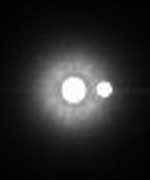
Image credit: ESA
This image, taken by ESA?s Rosetta comet-chaser spacecraft, shows the Earth-Moon system from a distance of 70 million kilometres. This is close to the maximum distance reached by the spacecraft so far this year.
However, this is a tiny distance compared to Rosetta?s epic journey when, in 10 years time, it will have travelled distances of over one thousand million kilometres from Earth, and about 800 million kilometres from the Sun, to meet Comet 67P/Churyumov-Gerasimenko.
This image was taken by the Navigation Camera System (NAVCAM) on board the Rosetta spacecraft, activated for the first time on 25 July 2004. This system, comprising two separate independent camera units (for back-up), will help to navigate the spacecraft near the comet nucleus. The cameras perform both as imaging cameras and star sensors, and switch functions by means of a refocusing system in front of the first lens.
At the comet, extremely high-precision measurements of the relative distance and velocity (between spacecraft and nucleus) will be needed. These are not achievable with the ground-based methods normally used with all other spacecraft or for normal Rosetta trajectory determinations.
In the meantime though, the cameras can also be used to automatically track the two asteroids that Rosetta will be visiting during its long cruise, Steins and Lutetia.
Original Source: ESA News Release
